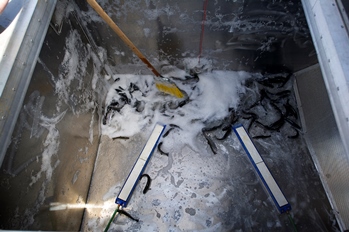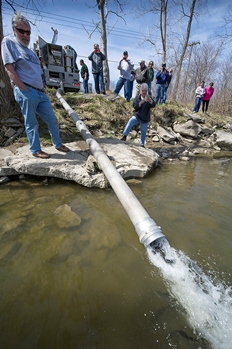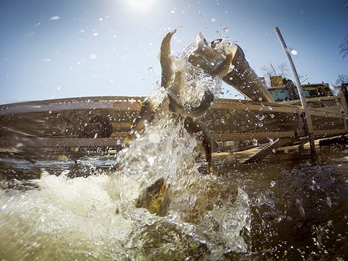Showcasing the DNR: Spring stocking a busy time for fisheries staff
Michigan Department of Natural Resources sent this bulletin at 05/01/2015 02:49 PM EDT|
Roughly 18 billion fish are stocked in Michigan waters each year. |
 |
 |
 |
 |
 |
Showcasing the DNR
Spring stocking effort keeps DNR fisheries staffers on their toes
and on the road Steve VanDerLaan is a busy guy this time of year.
Steve VanDerLaan is a busy guy this time of year.
As the Michigan Department of Natural Resources’ statewide fish-stocking biologist, it’s VanDerLaan’s job to get the annual hatchery production – in the vicinity of 18 million fish weighing 395 tons – out to the state’s lakes and streams during a roughly eight-week window.
He has plenty of help. Ed Eisch, who works out of the Platte River State Fish Hatchery and supervises the six-hatchery system, is in charge of raising the fish. Christian LeSage, a fisheries biologist who works out of Lansing, is in charge of allocating them. And a handful of workers load and drive the trucks. But VanDerLaan is in charge of getting them where they belong.
The DNR maintains a fleet of 18 fish-stocking vehicles. They range in size from a 300-gallon-capacity truck that’s small enough to negotiate two tracks to a 3,500-gallon, single-compartment truck used largely to transport salmon to Great Lakes ports.
“Our mainstay is a 1,200-gallon ‘Peterson’ unit with four 300-gallon tanks,” said VanDerLaan. “We have 10 of those. And we have four intermediate-class trucks, 2,000 gallons. Three of them are four-compartment units, and one is a single-compartment unit – it basically discharges the entire tank in one shot.”
Multiple-compartment vehicles are the way to go, VanDerLaan said. This is something he recognized since taking over this responsibility nearly 15 years ago.
“The larger units of the past were mostly single-compartments because they were for big plants in the Great Lakes,” he said. “They had the capacity to carry a large load for one stocking site, but they weren’t very versatile. In most cases, one stocking trip from the hatchery has multiple different stocking sites. So we’re getting away from single-compartment, hatchery-specific units and going to multiple-compartment vehicles that all the facilities can easily use. That’s the wave of the future.” 
The DNR recently added two new stocking trucks, a pair of 3,200-gallon units each with four 800-gallon compartments. The trucks have bottom discharges as well as an additional side-discharge port for each compartment, just in case of a valve failure.
The trucks cost around $300,000 apiece.
The last truck we turned in, we had for 20 years,” said VanDerLaan. “We baby those trucks. They’re very valuable.”
Stocking events often turn into a show as interested anglers arrive at stocking sites to see their future quarry. One of the trucks recently brought 32,000 steelhead to the Huron River in Monroe County, one of two deliveries made to the site. About two dozen spectators – several who pitched in to help DNR personnel hook up the discharge tubes – were on hand. Many were members of area fishing clubs, several of whom brought shotguns and cracker shells to haze any cormorants or gulls that might have come by looking for easy pickings.
The trucks are equipped with liquid oxygen tanks to saturate the water and make sure the fish are in a healthy condition when they arrive.  “Depending on the fish we’re hauling, each species behaves very differently on the truck during transport,” VanDerLaan said. “Brown trout tend to stack up on each other and if the water is not circulated uniformly, they’ll suffocate themselves in the corners of the tanks. Lake trout tend to congregate near the bottom of the tanks. Steelhead and domestic-strain rainbow trout tend to be all over the tank.”
“Depending on the fish we’re hauling, each species behaves very differently on the truck during transport,” VanDerLaan said. “Brown trout tend to stack up on each other and if the water is not circulated uniformly, they’ll suffocate themselves in the corners of the tanks. Lake trout tend to congregate near the bottom of the tanks. Steelhead and domestic-strain rainbow trout tend to be all over the tank.”
By the end of stocking season, the vehicles will have totaled close to 120,000 miles.
Fish stocking usually begins in late March, at ice out, VanDerLaan said, but at times he can’t be held to the calendar.
“If a hatchery is really jammed up with fish and they don’t have the room in the hatchery to hold them, we have to stock them out. We’re not above cutting holes in the ice to plant those fish if we have to.”
The work begins much earlier in the year when field biologists request fish for stocking. The biologists suggest three stocking levels per stocking site – what they would like (what the fish heads at the DNR call “Level 2”), the minimum they could live with, and the maximum number of fish they feel a site can take.
“We always shoot for Level 2,” VanDerLaan said, “but occasionally mistakes are made. A site might get double-planted for instance. It happens. So, if someone double-plants a site, how do we handle that? How do we make up those fish? Do we cut one site or do we take a small cut across the board? That decision becomes especially difficult when you get toward the end of the fish inventory. In cases like that, we solicit a variety of inputs so everyone knows what’s going on and why.
“It can get crazy. Vehicles break down – that can happen any hour, day or night, anywhere in the state – and we’ve got to get a mechanic or somebody out there to help them. It drives you a little bit nuts at times.”  As the DNR’s stocking biologist, VanDerLaan also coordinates the marking program. Fish are marked in a variety of ways – fin clips, coded wire tags implanted in their snouts,
As the DNR’s stocking biologist, VanDerLaan also coordinates the marking program. Fish are marked in a variety of ways – fin clips, coded wire tags implanted in their snouts,
jaw tags, passive integrated transponders (PIT tags) and oxytetracyclene treatment, which leaves a mark on the fish’s bones – for a variety of management and research purposes. VanDerLaan, who chairs the Fisheries Division’s marking committee, is responsible for purchasing the markers, maintaining the inventory and making sure it gets done.
When the annual stocking is completed, VanDerLaan, who divides his time between the Wolf Lake State Fish Hatchery and the Platte River facility, maintains the fleet, including design and purchase of new vehicles and disposal of retired ones. He makes sure his drivers are trained, tested and certified, and he handles all the necessary paperwork.
And he loves it.
“The job is very gratifying,” he said. “Like any job it has its days – some are way better than others. But I enjoy what I’m doing. I don’t raise any fish, but I work with a lot of good people who do. I just try to do my part and make sure they get where they’re supposed to go.”
For more information on Michigan fisheries, visit www.michigan.gov/fishing.
# # #
/Note to editors: Photos to accompany this story are available for download at www.michigandnr.com/ftp/outreach in the folder marked “Fish Stocking 15.” (Michigan DNR photos)
Captions:
DSK 522 102 – Michigan DNR fish-stocking biologist Steve VanDerLaan hooks up the tube to release fish from the truck into the Huron River.
DSK 522 105 – The public shows up to watch – and photograph – the DNR’s steelhead release at the Huron River in Monroe County.
DSK 522 116 – DNR fisheries workers use a broom to sweep the last fish out of the stocking tank at a steelhead release on the Huron River.
DSK 522 129 – Steelhead splash out of the DNR truck and into the Grand River near Lansing at a recent fish stocking./
Thank you for your interest in Showcasing the DNR. See past editions at www.michigan.gov/dnr-stories. Questions or comments? Please contact DNR public information officer Ed Golder at 517-284-5815 or goldere@michigan.gov.